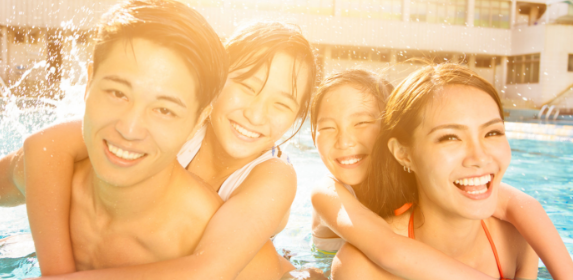(U.S.) – As kids and families head to the pool, beach, river, lake or ocean to cool off and have fun in the water this summer, the American Academy of Pediatrics urges all communities to make water safety a No. 1 priority – and that includes making swim lessons accessible for everyone.
“Everyone should have the opportunity to learn to swim,” said AAP President Kyle Yasuda, MD, FAAP. “This is an essential life skill for children, teens, and adults. It’s an important part of the ‘layers of protection’ that families and communities can put in place to protect children and teens around water.”
Unfortunately, not all communities have had the same access to swimming lessons. Historically, there have been barriers that prevented many African-American families from learning to swim, and today African-American teen boys have the highest risk of drowning of any age group. Among children ages 11 to 12 years, black children drown in swimming pools at 10 times the rate of white children, according to the Centers for Disease Control and Prevention.
“This is a problem we can solve,” said Nia Heard-Garris, MD, FAAP, chair of the AAP Section on Minority Health, Equity, and Inclusion. “Some communities have created innovative solutions to provide free or low-cost swim lessons and others have developed culturally sensitive lessons, and lessons for children with developmental disabilities or special health care needs. All children should have access to these potentially lifesaving skills.”
Drowning killed nearly 1,000 children in 2017, and is the No. 1 cause of injury-related death for children ages 1 to 4. Overall, African American children have the highest drowning fatality rates, followed by American Indian/Alaskan native, white, Asian American/Pacific Islander, and Hispanic.
The American Academy of Pediatrics published updated recommendations on drowning prevention in March 2019. The AAP recommends ‘layers of protection’ including:
- All children and adults should learn to swim. Most children will be developmentally ready for formal swim lessons between ages 1 and 4. Talk with your pediatrician about when your child will be ready.
- Not all swimming lessons are created equal. Choose a program that meets your family and child’s needs and skills, and one that will ensure they have basic water safety skills.
- Close, constant, attentive supervision around water is important. Assign an adult ‘water watcher,’ who should not be distracted by a cell phone, socializing, chores, or drinking alcohol. With young children or poor swimmers, the adult should be within an arm’s length, providing constant ‘touch supervision.’
- Empty wading pools immediately after use.
- Pools should be surrounded by a four-sided fence, with a self-closing and self-latching gate. Research shows pool fencing can reduce drowning risk by 50%.
- Adults and older children should learn CPR.
- Everyone, children and adults, should wear US Coast Guard-approved life jackets whenever they are in open water, or on watercraft. Small children and non-swimmers should wear life jackets when they are near water and when swimming. Inflatable “floaties” can’t be relied upon to protect kids.
- Parents and teens should understand how using alcohol and drugs increases the risk of drowning while swimming or boating.
“Drowning is fast, silent, and can happen even when it is not swim time. It happens to real families, families with good, attentive parents who never thought it could happen to them. I can’t emphasize enough how important it is to have many layers of protection to prevent drowning,” said Benjamin Hoffman, MD, FAAP, chair of the AAP Council on Injury, Violence & Poison Prevention.
Additional resources:
- AAP offers a toolkit of materials on drowning prevention, including infographics in English and Spanish that media outlets may reprint with permission. Visit www.aap.org/drowning to download materials.
- AAP offers a series of TV and radio Public Service Announcements, including Olympic skier Bode Miller and his wife Morgan Miller, and Tennessee teacher and mom Nicole Hughes. Visit https://digitalmedia.vnr1.com/2019/05/01/AAP_DrowningPreventation_PSAs_2019/ to download high-res versions to air.



